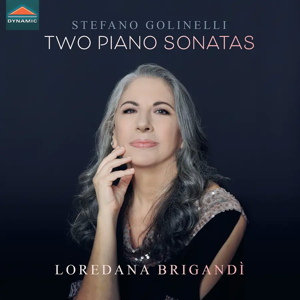
Stefano Golinelli (1818-1891)
Gran Sonata No.2 Op.53 (publ.1850)
Sonata No.1 Op.30
Loredana Brigandì (piano)
rec. 2023, Studio Musicale Griffa, Milan, Italy
Dynamic CDS7990 [61]
Italian music of the 19th century is so overwhelmed by vocal music and opera in particular that it is easy to forget that instrumental music was still being written. Among composers who wrote for the piano one might suggest Giovanni Sgambati (1841-1914) or perhaps Giuseppe Martucci (1856-1909) both of whom wrote prolifically for the instrument. Ferrucio Busoni too though the piano music that he is known for, beyond his transcriptions, dates from the the early 20th century. What of the generation before that? I would have been hard pressed to provide a name; Adolfo Fumagalli (1828-1856) virtuoso extraordinaire who didn’t live to see his 28th birthday but still had 112 opuses to his name is one that I can dig out of the recesses of my memory. Thanks to this release I can now add Stefano Golinelli to that very short list.
Biographical information on Stefano Golinelli seems to be in short supply; one paragraph on Wikipedia and not really much more in these booklet notes. He was born in Bologna and impressed Rossini enough at the age of 22 to be selected as piano professor at the Conservatory there. Piano virtuoso Ferdinand Hiller made his acquaintance two years later and suggested that he start a concert career describing him as the most distinguished performer in Italy. He evidently had a successful career as both pianist while still teaching at the Conservatory, a post he held until 1871 and was prolific as a composer, producing well over two hundred published works and many unpublished ones. Among his early successes were his Studi op.15 which Robert Schumann reviewed very favourably. Beyond those are other typical works of the virtuoso age, préludes, character pieces, variations and opera fantasies but also five piano sonatas of which Loredana Brigandì plays the first two.
The first sonata in D flat opens with an allegro molto appassionato, thatfor all its stiff chordal entry is in romantic style, somewhat after Schumann and Mendelssohn with sweeping left hand arpeggios and keyboard encompassing figuration. These influences continue in the andante mosso, a song without words based on a theme played with sparse accompaniment at first but which settles into the major key with a left hand accompaniment that has a repeating semiquaver pattern. The finale is a light-hearted mix of romping circus polka and romantic lyricism in flowing triplets. Sonata elements are present in its form but the whole is more like three character pieces that want to break free of their formal straightjacket.
The four movement second sonata, published in 1850 and dedicated to the Swiss piano virtuoso Sigismond Thalberg, opens with a declamatory statement that could have been written by Liszt. The rhythmic motif played here acts as a counter melody to the lyrical main theme and after musing on this the grandiose opening returns to herald the development section. For all its romantic fantasy Golinelli makes more interesting use of the themes here than he does in his first sonata and he continues this in the grand return to the main theme and short virtuoso coda. The andantino is a gentle song without words with elements of a barcarolle to its lilting music; I am reminded a little of the andante spianato prélude to Chopin’s op.22 polonaise. There is a brooding darker hued central section that again recalls Schumann and Mendelssohn. The presto third movement is a Beethoven like scherzo, virtuoso octaves announcing the its scurrying figuration. It has charming middle section that features little dancing figures playing my turn – your turn. The finale’s opening theme could have come from a Schubert or Beethoven sonata and seems a little out of place after what comes before it. It opens with an extended discourse on the opening themes that takes over half of its twelve minutes. Some more traditional virtuoso writing leads to a recapitulation of the opening in a more extrovert style but the mood relaxes again quite quickly only really growing to passionate heights to close the work.
These are both attractive works and I am glad to have made their acquaintance even if they are not pieces I am likely to return to often. The first sonata is Golinelli finding his way and by the second sonata he is surer of his path even if I find the finale doesn’t quite fit with the first three movements. Brigandì is excellent in bringing out their passion and quite melodious nature. There are some minor finger slips in the finale of the first sonata and I would have preferred that she didn’t slow down quite so much for that movement’s lyrical sections as they do get a little bogged down but on the whole she makes an excellent case for these sonatas by a composer that Schumann described as bringing a sudden sign of life for Italy.
Rob Challinor
Buying this recording via a link below generates revenue for MWI, which helps the site remain free.




















